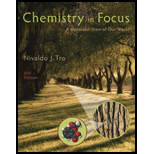
Interpretation:
The percentage of total calories obtained from fat is to be calculated.
Concept Introduction:
Fats and oils are composed of organic molecules called triglycerides. Triglycerides are the main sources of fats in the body.
Polyhydroxy
Fiber is the carbohydrate that contains more than two molecules or units of glucose linked by
The
Answer to Problem 61E
Solution:
a)
b)
c)
Explanation of Solution
a) In Little Debbie choco-cakes,
Fats have a high calorific value, that is, up to
The number of calories in each product can be calculated as follows:
Thus, the total number of calories obtained is
The percentage of fatscan be calculated as follows:
Substitute
Therefore, the percentage of calories obtained from fats is
b) In aSnickers bar,
The number of calories in each product can be calculated as follows:
The percentage of fats can be calculated as follows:
Substitute
Therefore, the percentage of calories obtained from fats is
c) In Jerseymaid peach yoghurt,
The number of calories in each product can be calculated asfp;; pws:
Thus, the total number of calories obtained is
The percentage of fats can be calculated as follows:
Substitute
Therefore, the percentage of calories obtained from fats is
Want to see more full solutions like this?
Chapter 18 Solutions
Chemistry In Focus
- Calculate the number of calories in a 5 fluid ounce glass of red wine that contains 2.6 g of carbohydrates and 12.9 g of alcohol.arrow_forwardA healthful diet should have a distribution of macronutrients. In the following, match the caloric content with a healthful diet's macronutrients. Protein Fats Carbohydrates highest caloric content intermediate caloric content lowest caloric contentarrow_forwardThe grams of Carbohydrates in one apple if the apple has no fat no protein and provides 72 kc of energy.arrow_forward
- how many grams of carbohydrates are in a 2400 kcal diet with 45% of total kcal from carbohydratesarrow_forwardOne gram of alcohol provides 7 Calories. Calculate the number of Calories in a 5 fluid ozoz glass of red wine that contains 3.0 gg carbohydrate and 12.1 gg alcohol.arrow_forward1.) Expenditure of energy that is dependent on body weight, sex, age due to a. basal metabolic rate b. environmental temperature c. physical activity d. thermogenic effect 2.) It is associated with food consumption a. thermogenic effect b. basal metabolic rate c. Physical activity d. environmental temperature 3.) It's our daily energy expenditure a. basal metabolic rate b. environmental temperature c. thermogenic effect d. physical activityarrow_forward
- Mass in one serving (g) Calories in one serving (kcal) Fat 8 Carbohydrates 37 Protein 3 Calculated total Calories per-serving(kcal): Total Calories per serving from label: 230 Calarrow_forwardA college student who has been feeling fatigue decides to take an energy-boosting supplement advertised on a television infomercial and endorsed by a professional athlete. She reports feeling more energetic after taking the supplement but later discovers the supplement is only made of salt. What did the student experience? A. The effectiveness of the energy supplement working in her body B. The placebo effect; the student believing the supplement was working to increase energy C. An increase in nerve conduction caused by the salt tablet D. An increase in blood pressurearrow_forwardA stalk of celery has a caloric content (fuel value) of 9.0 kcal.If 1.0 kcal is provided by fat and there is very little protein, estimatethe number of grams of carbohydrate and fat in the celery.(a) 2 g carbohydrate and 0.1 g fat (b) 2 g carbohydrate and1 g fat (c) 1 g carbohydrate and 2 g fat (d) 32 g carbohydrateand 10 g fatarrow_forward
- Use the following example of a nutrition label answer the questions below. Fat:Mass in one serving (g)Calories in one serving (kcal) Carbohydrates: Mass in one serving (g) Calories in one serving (kcal) Protein: Mass in one serving (g) Calories in one serving (kcal) Calculated total Calories per serving (kcal): Total Calories per serving from label (Cal):arrow_forward2. Three-layer of wedding cake approximately weights 500grams has 425g carbohydrates, 50g fats and 25g protein. Calculate the total energy of food.arrow_forwardA cup of whole milk contains 12g of carbohydrate 9 g of fat and 5 g of protein. How many kcal (cal) does a cup of milk contains? Round answer to the tens placearrow_forward
 Chemistry In FocusChemistryISBN:9781305084476Author:Tro, Nivaldo J., Neu, Don.Publisher:Cengage Learning
Chemistry In FocusChemistryISBN:9781305084476Author:Tro, Nivaldo J., Neu, Don.Publisher:Cengage Learning Chemistry for Today: General, Organic, and Bioche...ChemistryISBN:9781305960060Author:Spencer L. Seager, Michael R. Slabaugh, Maren S. HansenPublisher:Cengage Learning
Chemistry for Today: General, Organic, and Bioche...ChemistryISBN:9781305960060Author:Spencer L. Seager, Michael R. Slabaugh, Maren S. HansenPublisher:Cengage Learning Chemistry: The Molecular ScienceChemistryISBN:9781285199047Author:John W. Moore, Conrad L. StanitskiPublisher:Cengage Learning
Chemistry: The Molecular ScienceChemistryISBN:9781285199047Author:John W. Moore, Conrad L. StanitskiPublisher:Cengage Learning



